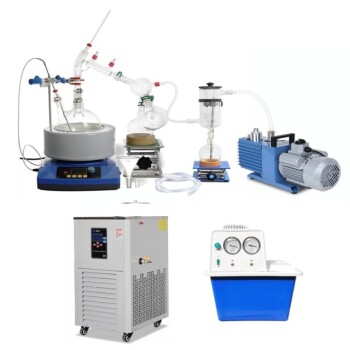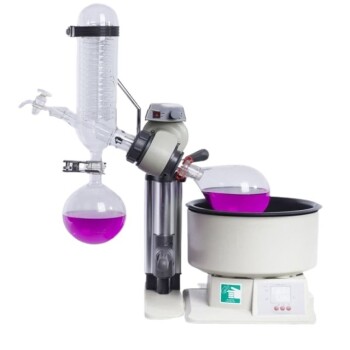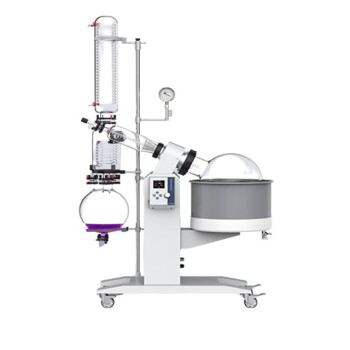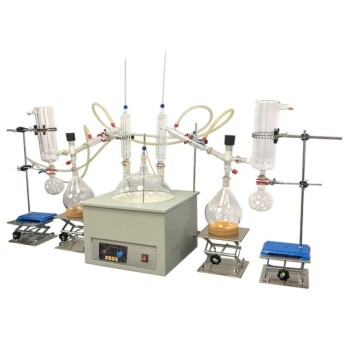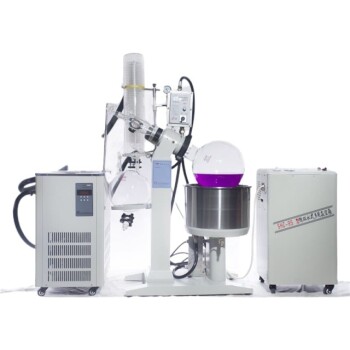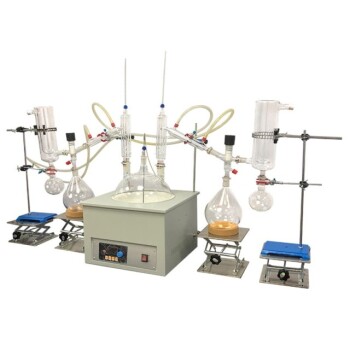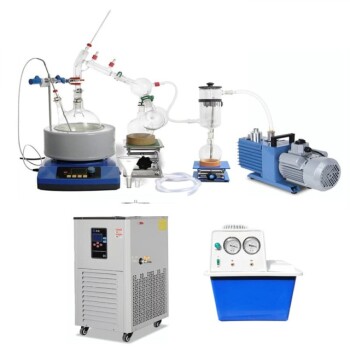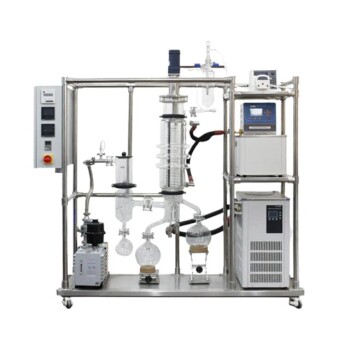Introduction to Rotovap Distillation
Rotovap distillation is a common technique used to separate solvents from reaction mixtures. It involves the use of a rotary evaporator, which is a piece of laboratory equipment that utilizes rotation and heat to remove solvents or other compounds from a sample. Rotovap distillation is particularly useful in the cannabis and hemp industries, where it is used to extract cannabinoids and other desirable compounds from plant material. The use of rotovap distillation has several benefits, including increased efficiency, improved purity, and reduced processing time. However, it requires proper usage and adherence to safety guidelines to ensure successful distillation.
Table of Contents
How Rotovap Works
Rotovap, short for rotary evaporator, is a laboratory equipment used for distillation, a process of separating a mixture into its components by heating and cooling. It is often used to purify and concentrate compounds, such as solvents or natural products. Here is a step-by-step guide on how rotovap works:
Step 1: Heating the mixture
The rotovap works by rotating a flask containing the mixture to be distilled under vacuum. This reduces the boiling point of the mixture, allowing the volatile components to evaporate and be collected in a separate flask. The rotating flask also ensures that the mixture is heated evenly, preventing it from overheating or causing chemical reactions.
Step 2: Lowering the pressure
While traditional distillation purifies a liquid by heating it up to evaporate and cooling it down with a condenser to reclaim the distilled vapors, a rotary evaporator uses a gentler method to achieve a similar outcome. In a nutshell, the rotary evaporator lowers the pressure of the sample's environment using a vacuum, which lowers the boiling point significantly.
Step 3: Collecting the components
The collected components can then be further purified or analyzed. The rotovap is a versatile and efficient tool for laboratory work, but it requires proper training and safety precautions to use effectively. Beginners should familiarize themselves with the equipment and its components, as well as the principles of distillation, before attempting to use a rotovap.
Four components that affect the rate of distillation
Four components affect the rate of distillation: temperature of the heating bath, pressure of the distillation, speed of rotation, and size and power of the system. Generally, the larger the flask and the higher its RPM, the quicker the evaporating process. The speed of distillation is important because the faster you distill without saturating, the better the flavor.
Rotary Evaporator Parts
A rotavap is an instrument in chemical laboratories used for the effective separation of solvents from given samples via distillation. The device is also used in molecular cooking to prepare extracts and distillates. It has a motor unit that rotates the vials containing your sample, a vapor duct that channels the vapor coming from the sample, a water bath to heat your sample, a condenser into which coolant mixtures such as acetone and dry ice are placed, a collecting flask at the bottom of the condenser, where the distillate collects after re-condensing, and a mechanical system to adjust the position of the evaporation flask either from the water bath or out of the water bath.
Rotary Evaporator Working Principle
The rotatory evaporator working principle is that the boiling point of liquids lowers on decreasing their pressure. This allows the solvent to vaporize at lower temperatures than when boiled in a normal atmosphere. You should choose a vacuum pump for your rotavap that will guarantee an improved evaporation efficiency.

Benefits of using rotovap
Rotary evaporators, also known as rotovaps, are widely used in laboratories for their effectiveness in distillation processes. The following are some of the benefits of using a rotovap:
Lower temperatures
One of the main advantages of using a rotovap is that it allows for the separation of solvents and compounds at lower temperatures compared to traditional distillation methods. This is due to the vacuum created inside the rotovap which lowers the boiling point of the solvents.
Continuous process
Rotovap distillation is a continuous process which saves time and increases efficiency. Unlike traditional distillation methods that require the heating and cooling of the solution multiple times, the rotovap allows for the solution to be continuously circulated through the system.
Gentle process
The rotovap is a gentle process that allows for the preservation of the delicate properties of the compounds being distilled. This is important in industries such as pharmaceuticals, where the purity of the final product is critical.
Versatility
Rotary evaporators are highly versatile and can be used in various fields such as pharmaceuticals, chemical research, and food and beverage production. They can be used to separate and purify different components of a mixture, making them an essential laboratory tool.
Solvent recovery
Rotovaps are also useful for solvent recovery, which can save money and reduce waste. Solvent recovery is particularly important in the cannabis extraction industry, where solvents such as ethanol are used to extract cannabinoids and terpenes from trichomes.
Environmental benefits
Rotary evaporators are environmentally friendly and efficient. They use less energy compared to traditional distillation methods, which require the heating and cooling of the solution multiple times. The use of a rotovap also reduces waste, as solvents can be recovered and reused.
In conclusion, the rotovap is a highly efficient and versatile laboratory tool that offers numerous benefits for distillation processes. It allows for the separation of solvents and compounds at lower temperatures, is a continuous and gentle process, and can be used in various fields. The rotovap is also environmentally friendly and can save money through solvent recovery.
General Rules for Usage
When using a rotary evaporator or rotovap, it is important to follow some general rules to ensure safety and avoid accidents. Here are some important rules to keep in mind:
Flask Attachment
- Always ensure that the flask is securely attached to the rotovap.
- Use a metal or Keck clip to secure the flask and bump trap.
- Do not exceed the maximum volume of the flask and the bath.
Safety Measures
- Always use gloves and safety glasses when handling the equipment and solvents.
- Do not leave the rotovap unattended when in use.
- Always use a vacuum pump with a proper vacuum gauge to prevent overpressure.
Cleaning and Maintenance
- Clean and maintain the rotovap regularly to ensure proper functionality and longevity.
By following these general rules, you will be able to efficiently and safely use the rotovap for your distillation needs.
Who is Using Rotovaps?
Rotovap distillation is a popular technique used in laboratories to separate solvents from a mixture of compounds. It involves placing the mixture in a flask, which is then rotated at a constant speed while a vacuum is applied to remove the solvent. This process is particularly useful in the extraction of natural products, such as essential oils, and the purification of synthetic compounds. But who is using rotovaps?

Researchers in Chemistry, Biochemistry, and Pharmaceuticals
Rotovaps are commonly used by researchers in chemistry, biochemistry, and pharmaceuticals. In these industries, researchers use rotovaps to purify and concentrate compounds for further analysis or use. The rotovap's ability to separate solvents quickly and efficiently makes it a valuable tool for these industries.
Food and Beverage Industry
Rotovaps are also used in the food and beverage industry to extract pure flavors and distillates. In molecular gastronomy, chefs use rotovaps to prepare distillates and extracts with the purest flavors. In the alcohol industry, rotovaps are used in the distilling of spirits and to extract flavors from herbs and fruit to add to cocktails and other alcoholic beverages.
Cannabis Industry
In recent years, the cannabis industry has also adopted the use of rotovaps. Rotovaps are used in the extraction of active compounds from the plant for medicinal or recreational purposes. The lower heating temperatures of the rotovap help preserve the quality of the oil and make the rotovap safer and more energy-efficient.
Biofuel Research
Rotovaps are used for extractions in biofuel research to purify biomass components that are useful for energy generation. Researchers use rotovaps to separate volatile components, which most biofuels contain.
In conclusion, rotovaps are an essential tool for anyone who needs to separate solvents from a mixture of compounds quickly and efficiently. The rotovap's ability to purify and concentrate compounds has made it a valuable tool in many industries, including chemistry, biochemistry, pharmaceuticals, food and beverage, cannabis, and biofuel research.
Rotovaps in Cannabis and Hemp Extraction
Rotovaps, also known as rotary evaporators, are essential equipment in the cannabis and hemp extraction industry due to their efficiency and ability to produce high-quality extracts. The process involves heating a mixture in a flask and then evaporating the solvent under vacuum, concentrating the desired compound. The condensed vapor is then collected in a separate flask.

Why Use a Rotovap in Cannabis and Hemp Extraction?
Using a rotovap in cannabis and hemp extraction produces high-quality extracts with better purity and a higher yield. The process is also more efficient compared to other methods. However, using a rotovap requires some level of expertise, and beginners should take necessary precautions to avoid accidents. It is important to ensure proper ventilation, use protective gear, and follow the manufacturer's instructions.
How to Use a Rotovap in Cannabis and Hemp Extraction
- Preparation: Before using a rotovap, ensure that the equipment is clean and dry. Check that all connections are properly secured and that the vacuum pump is functioning correctly.
- Loading the flask: Load the flask with the cannabis or hemp extract and the solvent, ensuring that the flask is not more than 50% full.
- Setting the temperature: Set the temperature of the heating bath to the required temperature, which depends on the solvent used.
- Starting the vacuum pump: Start the vacuum pump to create a vacuum in the system.
- Starting the rotation: Begin rotating the flask to increase the surface area of the solvent, which quickens the rate of evaporation and improves efficiency.
- Collecting the extract: As the solvent evaporates, it condenses in the condenser and is collected in a separate flask.
Precautions and Safety Measures
When using a rotovap, it is important to take necessary precautions to avoid accidents. Ensure proper ventilation in the laboratory, use protective gear such as gloves and goggles, and follow the manufacturer's instructions. Be sure to avoid overfilling the flask, which can cause the solvent to spill over and cause injury or damage to the equipment.
Conclusion
Using a rotovap in cannabis and hemp extraction is becoming increasingly popular due to its efficiency and ability to produce high-quality extracts. However, it is important to ensure proper precautions and safety measures are taken to avoid accidents. By mastering the use of a rotovap, one can achieve a higher yield of extracts with better purity, making it a valuable tool for laboratory professionals in the cannabis and hemp industry.
Procedure of Operating a Rotary Evaporator
Setup
- Pour the mixture of solvent and desired compound in a round bottom flask. Best results are achieved when the flask is filled less than half full of the solution.
- Fill the rotovap cold traps with dry ice.
- Attach a glass “bump trap” which prevents any solution from entering the main part of the rotovap. Secure with a Keck clip.
- With a Keck clip attach the flask and bump trap to the adapter portion of the roto-evaporator.
- Lower the flask into the water bath. This helps to prevent the flask from disconnection.
Operation
- Start the rotation. Different speeds are preferable for different volumes.
- Slowly start increasing the vacuum. The vacuum is at the proper strength when: 1) condensation of the solvent can be seen on the cold finger or in the receiving flask, or 2) the solvent begins to bubble.
- Turn on the heat for the water bath. Recall from general chemistry that vacuum reduces the boiling point of the solvent, so significantly lower temperature is needed to evaporate the solvent using a rotovap than at STP.
- Adjust the vacuum setting as needed.
- When all solvent has been removed turn off the vacuum and return the flask to atmospheric pressure.
- Stop the rotation.
- Raise the flask from the bath.
- Remove the flask from the adapter.
Tips and Tricks
- Distilled water should be used in the heating bath to minimize the scale build up in the bath which coats the thermistor and heating coils. It is very difficult to remove and reduces the efficiency of the bath.
- There is no need to turn off the rotary evaporator unless it is the end of the lab period.
- The ground glass joint holding the flask does not need to be greased, but on rare occasions it (or the bump bulb) may get “frozen”. Some companies sell special joint clips that can free frozen joints simply by screwing them in one direction.
- To remove algae gunk from the inside of a coiled water condenser, the condenser has to be removed from the rotavap and the coil is soaked in a dilute nitric acid solution for a few hours. After carefully rinsing the insides, the rotavap is reassembled. All standard safety precautions should be followed when working with nitric acid!
A rotary evaporator is an essential tool for chemical processes in various fields, and following the correct procedure is crucial to getting the desired results. The above steps for setting up and operating a rotary evaporator are straightforward, but it is important to pay attention to the details, as small mistakes can lead to incorrect results. The tips and tricks mentioned above can also help you to get the most out of your rotary evaporator and extend its lifespan.
Tips and Tricks for Successful Distillation
Successful distillation using a rotary evaporator requires proper equipment setup, monitoring, and optimization. Here are some tips and tricks to help ensure a successful distillation process.
Equipment Setup
Before commencing the distillation process, ensure that all equipment is set up correctly and that all joints are well-sealed. Use a vacuum pump with a cold trap to prevent vapors from escaping. You should also adjust the temperature, pressure, and rotation speed based on the properties of the solvent and the mixture being distilled.
Solvent Selection
Use a good quality solvent to ensure efficient separation and avoid contamination. If possible, choose a solvent with a lower boiling point than the mixture being distilled to avoid damaging the sample.
Glassware Cleaning
Clean all glassware before and after use to prevent residual impurities from affecting your results. Use a mild detergent and water to clean the glassware. Rinse the glassware thoroughly with water and dry it before use.

Monitoring the Process
Monitor the process closely and make adjustments as needed. To prevent bumping, ensure that the solvent doesn't reach the neck of the flask. If the bubbles seem to be in danger of reaching the neck, repressurize the system by fully opening the stopcock to cease boiling. Repeat until boiling has ceased, and solvent is steadily streaming from the condenser. Only then do you fully close the stopcock.
Temperature and Pressure
Adjust the temperature, pressure, and rotation speed based on the properties of the solvent and the mixture being distilled. When condensation begins to form on the exterior surface of the flask, lower it into the heat bath approximately half way. Occasionally check to ensure nothing has gone wrong and make sure to make the necessary adjustments as required.
Experience
As you gain more experience, you'll become more familiar with the nuances of rotary evaporation and be able to optimize your process for better results. With the tips mentioned above in mind, you'll be well on your way to successful roto-vap distillation.
In conclusion, using a rotary evaporator for distillation requires careful attention to detail, proper equipment setup, and efficient monitoring of the distillation process. With these tips and tricks, you can ensure successful distillation of your samples using a rotary evaporator.
CONTACT US FOR A FREE CONSULTATION
KINTEK LAB SOLUTION's products and services have been recognized by customers around the world. Our staff will be happy to assist with any inquiry you might have. Contact us for a free consultation and talk to a product specialist to find the most suitable solution for your application needs!


